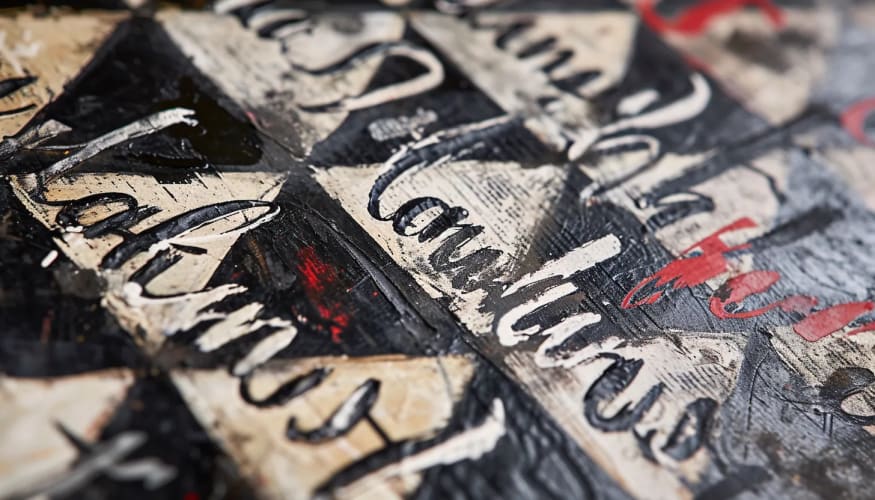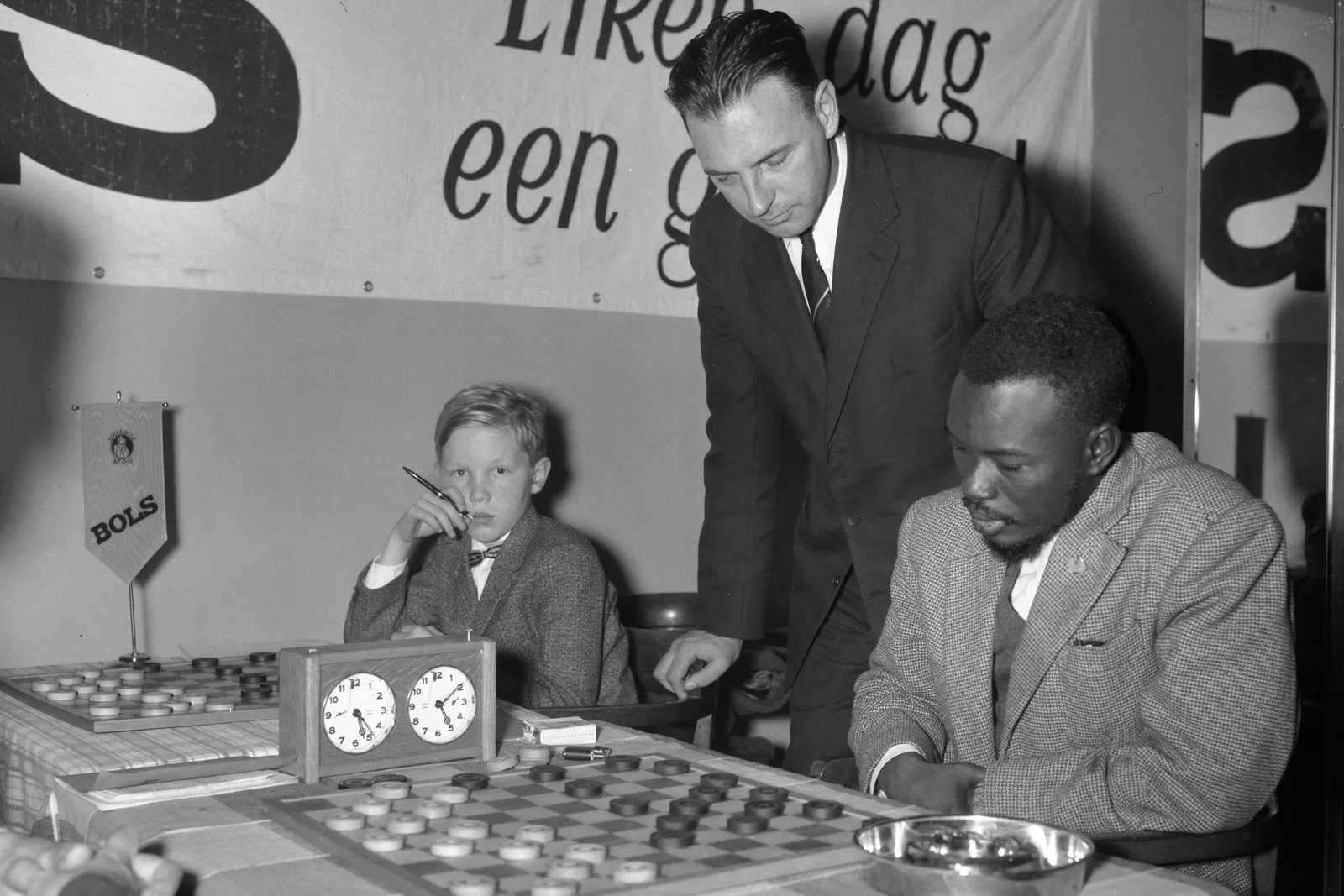The exact moment I came into contact with the game of draughts is something I can no longer recall. That might sound strange coming from someone who has repeatedly referred to himself as a "numbers freak", but nonetheless, it’s the truth. The only thing I can state with near absolute certainty is that I must have been nine or ten years old when my parents taught me the rules of the game.
(On the back cover of the first volume of “Mijn Hollands Universum (My Dutch Universe)”, ChatGPT, the humble chatbot (“Oh no—no need to mention my name”), which kindly agreed to write the cover text, conveniently settled on “nine years”. But that, apparently, is open to debate.)
I think I was more likely nine than ten, because it feels as though an eternity passed (though I realize that may not mean much) before, shortly after my eleventh birthday (December 15, 1960), my father accompanied me to sign up at the Christian Draughts Club Amsterdam. But no record was ever made of that life-altering moment—In the grand scheme of the cosmos, utterly insignificant, but decisive in shaping my life—when my parents took the cardboard draughts board out of the cupboard, a board that had intrigued me already for so long. And there’s no one (anymore) I can ask about it. That particular event must have occurred ‘sometime’ in 1959, at the latest 1960. I can’t pinpoint my ‘birth as a draughts player’ any more precisely than this; the relatively broad margin of a year is simply impossible to narrow down.
As mentioned earlier, I became a member of CDA during the winter of 1960/1961, initially attending only the youth section led by Leen de Rooij and Henk Smit on Saturday afternoons at the then Pniëlkerk (now Podium Mozaïek) on the Bos-en-Lommerweg. But two or three months later, I made my transition to the "senior" section, which held its club meetings at the Max Euwe Huis on the Bilderdijkstraat. This allowed me to play my first ‘official’ game (with a clock and mandatory notation) on Friday, April 14, 1961, against Wim Zoutman, a player who—if I recall correctly—not long after left CDA to join the Jehovah’s Witnesses.
My inexperience and extremely limited, if not entirely non-existent, knowledge of the game (my only ‘compass’ was the booklet “Ken Uw Sport (Know Your Sport)” by the highly praised J.F. Moser) meant that my first games were simply unwatchable. It is no coincidence, therefore, that a modern top player who –more than a decade ago now– took on the editorial task of my autobiography at my request, strongly advised me not to publish games like Sijbrands-Zoutman 1961. So far, I’ve wisely followed that advice.
However, I improved rapidly, and my game progressed at a fast pace. On the one hand, this was due to the weekly lessons from R.C. Keller, who, during the Lucas Bols tournament of 1961/1962—where I had the privilege of recording Baba Sy’s many victories!—had taken notice of me. On the other hand, it was due to the studying of the tournament book on the 1948 World Championship, compiled by Piet Roozenburg, which I had received as a gift from my club and neighbourhood friend Piet Verweij (see also page 366 of “Mijn Hollands Universum”). In any case, by the end of that first year, I had earned promotion from the B group to the A group in CDA’s internal competition, where I had finished second behind Paul Johannesen. And in the final three months of 1962, I achieved my first individual success by winning the Amsterdam Youth Championship with a score of 19 points from 10 games (my only draw being against Henk Werner).
Earlier that year, on Keller’s recommendation, I had also joined Gezellig Samenzijn (GS), the “Club of Masters”, as Moser describes it in his "Zak-encyclopedie voor Dammers (Pocket Encyclopedia for Draughts Players)” (Baarn, 1960). At GS, I participated in the Youth Competition in the summer of 1962, engaging, among others, in a sharp battle in the so-called Jurg-variant with theoretician Rob Jansen. I also represented my new ‘part-time club’ in the Youth Team Competition (for five-player teams), where our GS II team became champions by – an incredible triumph!– defeating the older boys of GS I.
What had been brewing for some time, and what my first club likely feared, became a reality in March 1963: I permanently moved from CDA to the much stronger GS. I was given a place in their third (senior) team, where I won four games—including victories over KDA’s J. Huismans and the notable Tinus Delsen of APGS—but also lost a highly instructive game to the equally notable DSTO player Van den Heuvel. Incidentally, Van den Heuvel had spectacularly defeated multiple Dutch Championship finalist André (“Puk”) Ligthart in the 1951 club competition. For those readers without Moser’s "Modern Openingsspel (Modern Opening Play)” (see page 27 of the first volume): in Van den Heuvel-Ligthart 1951, the same explosive 19x19 position arose after 17 moves as it would in the Dutch Championship game W. de Jong-Bom 1955 four years later! And Ligthart went down in exactly the same, slightly naïve manner as Bom!
In late May or early June 1963, I achieved my second individual success. In the Youth Tournament organized by Gezellig Samenzijn—which included members of GS such as Herman van Westerloo and Dick Roelofs, alongside players like Anton Schotanus and Fred Ivens, who already had a degree of national recognition—I scored 12 points from 7 games. This was more than enough for the first place, finishing 2 points ahead of the trio Ivens/Schotanus/Van Westerloo.
Meanwhile, I had expanded my ‘draughts library’ with the so-called “Game Booklets” published by the Amsterdam District (read: secretary Klaas van Netten), which featured the most important competitions held at the time. These were stencil-copied booklets containing only the notations of the played games, occasionally enhanced with a stray question or exclamation mark authorized by R.C. Keller. Through these Game Booklets, I familiarized myself with the Dutch Championships of 1961-1963 (Wim de Jong! Piet Roozenburg!) and the 1960 World Championship, where Shchegolev, Baba Sy, and Kouperman stood out as a class apart. Additionally, during the previously mentioned Lucas Bols tournament of 1961/1962, I had acquired the twenty games played by Shchegolev and Kouperman in their first world title match in the fall of 1961. The four incredibly densely typed A3 sheets that South Holland master Philip Ham—famous for his brilliant 1939 victory over then-world champion Raichenbach—had tried to sell at Amsterdam’s Hotel Krasnapolsky, are still in my archive more than 62 years later.
That I draw such explicit attention to those—still highly enjoyable in 2024!—match games from 1961 arises partly from the fact that I was strongly inspired by the 9th match game between Kouperman and Shchegolev during my duel with Schotanus in the 1963 Youth Tournament. I’m not exaggerating: in the 13x13 phase after 32 moves, my position was identical to Kouperman’s! And because I—unlike Kouperman, who saw Shchegolev fend off the danger just in time—had to move, I was able to execute a wing attack that proved decisive in all variants!
(That said, just before this, in the 14x14 phase, I had taken a bizarre, entirely atypical setup that betrayed my complete lack of experience. It was, in fact, my very first encounter with the Semi-Fork, a type of game that—as I perceive it—is still subject to differing opinions today. But the last twenty moves of that game, no one can take them away from me.)

